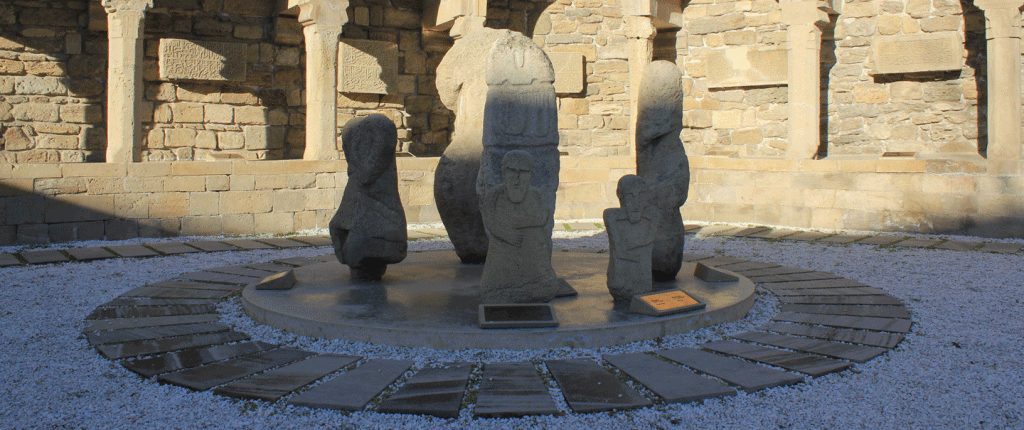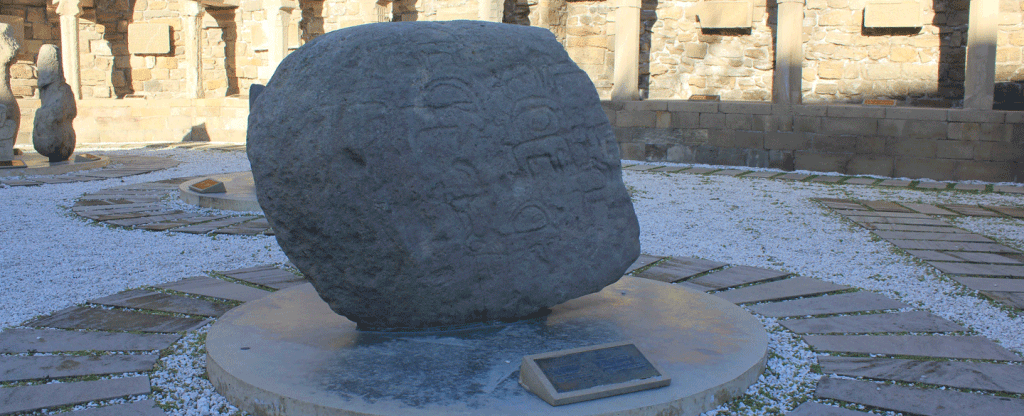“

ANCIENT HISTORY
Ancient history and religion
Azerbaijan is based in the Caucasus region of Eurasia. The Caspian Sea lies to the east and Russia’s Daghestan region to the north. Georgia lies to the northwest, Armenia and Turkey to the southwest, and Iran to the south.
Zoroastrianism
The earliest groups of people to occupy this territory in the first millennium BCE were the ancient civilizations; the Mannaeans, the Medes and the Caucasian Albanians. During Median and Persian rule the Caucasian Albanians adopted Zoroastrianism (fire worship). Moreover, the origin of the word Azerbaijan is often traced back to, the Persian word ‘Azer’ meaning fire.
The Absheron peninsula around Baku became a spiritual hub for Zoroastrianism due to its distinct natural phenomenon. Huge amounts of oil are buried deep inside the ground and as a result gas seeps out through fissures in the earth’s surface and periodically catches fire. Sites where this occurred were considered sacred and fire worshipping temples were built around them.
In medieval times Zoroastrians believed that Azerbaijan was the native land of the prophet Zarathustra or Zoroaster. Today a gas torch burns atop Baku’s famous Maiden Tower. Moreover, some suggest the tower could have been a site of Zoroastrian workshop as far back as 2,500 years ago.
Archaeological excavations have revealed an altar located near the base of the Maiden Tower that contained traces of oil and fire leading many to believe that the basin was kept filled with oil in order to keep an eternal fire burning.
Baku’s oil continued to be used as a source of holy fire during the Middle Ages even after most Azerbaijanis had converted to Islam. In the eighteenth century the burning of oil of the Absheron peninsula attracted fire worshippers from India who built a temple of fire known as Ateshgah in the Surakhani village near Baku.
Christianity and Islam
There was growth in Christianity from the Albanian influence before the arrival of Muslim Arabs and more importantly Muslim Turks. The Turkic tribes arrived as small groups whose conquests led to the ‘Turkification’ of the population. The largely native Caucasian and Iranian tribes adopted the Turkic language and converted to Islam over a period of hundreds of years. Azerbaijan officially adopted Islam between the seventh and eighth century. The language of Azerbaijan today is Azerbaijani which is loosely related to the Turkish spoken in Turkey.
The fire temple of Baku ‘Baku Ateshgah’
In 1858 French novelist Alexandre Dumas visited the Caucasus on his nine month journey through the area. A particular place that captured his attention was Ateshgah the fire temple on the outskirts of Baku. Dumas recorded his impressions richly describing Ateshgah. He was particularly inspired by the panoramic view from atop the temple and was in awe of the Great flames that soared into the air shooting from hundreds of fissures in the ground. Today the Ateshgah site has been converted into a museum.
Introduction of Christianity
The spread of Christianity in Azerbaijan is connected with Caucausian Albania which occupied nearly all of the territory of present-day Azerbaijan between the fourth century and eight century BCE. The religion of Albania was centered on the worship of three divinities from the Roman histories. Whilst the Turkic tribes of Caucasian Albania such as the Huns the Khazars, the Bulgars and the Sabirs, worshipped Tengri the Turkic god of the blue sky.
Christianity arrived in Caucasian Albania during the first centuries AD as the first missionaries arrived from Syria and Jerusalem. Saint Bartholomew, one of Christ’s twelve apostles, is perhaps the best known preacher to have set foot in the terrain of present day Azerbaijan. He is thought to have travelled from India following the caravan routes of pilgrims heading toward ‘fire country’. As Caucasian Albania was the centre of Zoroastrianism tradition it is believed Bartholomew was martyred by pagan priests who were infuriated by the success of his sermons.
Orthodox Christians still hold that the Maiden Tower in Baku is the same Temple of Arta where Saint Bartholomew was slaughtered by outraged Zoroastrians. In the 19th century while under Russian imperial rule Christians erected a small church dedicated to Saint Bartholomew right next to the Maiden tower. The church was destroyed during the Stalinist era in the 1930s at a time under the USSR when religion was systematically persecuted.

Establishment of Oil Plants
Azerbaijan has long been known for its rich oil resources. The earliest exploration of onshore oil fields dates back to at least the seventh century BCE. Thus, during the age of the Median Kingdom in what is now referred to as Southern Azerbaijan in Iran, the Median province that bordered Assyria became the first place in the world to extract oil from wells. Typically, in the first century BCE oil was drawn from shallow wells in leather buckets
Oil played an important role in everyday lives of the Medans the Caspians and other ancient tribes of Azerbaijan. It was used to fuel lamps and was applied to spear tips to light them. It was also used to make more powerful weapons; what Greek soldiers referred to as throwing ‘median oil’.
During the Middle Ages oil began to be extracted on a larger scale. By the fifteenth century up to two hundred ‘camel bales’ of oil were being exported from Baku every day. A single ‘bale’ was roughly three hundred kilograms, so a regular supply of around sixty thousand kilograms of oil was leaving Baku daily.
The Maiden Tower
The Maiden Tower is one of the most famous monuments of Baku. It is a distinctively shaped eight storey stone tower built upon a natural stone ledge. Historians continue to debate its origins and the facts of when it was built and what purpose it served.
Theories
Soviet archaeologists falsely identified it as a military fortress built in the twelfth century by the architect Masud ibn Davud whose name was found on a stone inserted into one of the walls. It was later discovered that the stone had been inserted at a later date.
Only after Azerbaijan gained independence did historian Shamil Fatullayev publish his architectural encyclopaedia of Baku in which the tower is dated to the pre-Islamic period thirteen hundred years ago. Sara Ashurbeyli, a prominent historian and expert in the history of Baku has calculated that the tower foundations were originally built between the 4th and 6th centuries. This conclusion is partly supported by historian Bretanitskiy who has postulated that the tower was partly built in the 5th to 6th centuries and then later completed in the 12th century.
Another theory was developed by David Akhundov that the tower was never used for a military purpose but rather served as an ancient Zoroastrian fire worshiping temple. Akunhdov wrote that, ‘At the beginning of the first millennium BCE there was an eight storied temple (Maiden Tower) devoted to alters with seven-coloured fires burning in honor of the Pantheon of Gods.
The story of the Maiden
There are a number of competing explanations for the name of the tower. The most common based on the legend of a maiden, the daughter of the Khan of Baku, who threw herself off its top to her death in the waves below. In some sources she is said to be sister, not daughter, of the king who was incarcerated by her brother. To escape from the ignominy of incarceration, she jumped to her death from the top of the tower. Another explanation for the name is testament to the fact that the tower has never been taken by force (hence a metaphorical reference to ‘virginity’)
Yanar dag
Yanar Dag (translated as “burning mountain”) is a natural gas fire which unlike the Ateshgah site still blazes continuously on a hillside. It is located on the Absheron Peninsula on the Caspian Sea near Baku. Flames are known to jet into the 3 metres into the air from a thin, porous sandstone layer. Unlike mud volcanoes, the Yanar Dag flame burns fairly steadily due to the steady release of gas from the subsurface. It is claimed that the Yanar Dag flame was only noted when accidentally lit by a shepherd in the 1950s. There is no seepage of mud or liquid, which distinguishes it from the nearby mud volcanoes of Lökbatan or Gobustan.
The Yanar Dag fire is never extinguished. Around this open fireplace the atmosphere is filled with the smell of gas. Even the surface of streams near Yanar Dag fire can be ignited with a match. These streams, which otherwise appear calm, are known as Yanar Bulaq: “burning springs”. There are several such springs in the vicinity of the Vilascay River, where the local people take curative baths.
Only a handful of such Fire Mountains exist today in the world, and most are located in Azerbaijan. Due to the large concentration of natural gas under the Absheron Peninsula, natural flames burned there throughout antiquity and were reported on by historical writers such as Marco Polo. The naturally occurring fire burns in colourful flames most impressively at dusk. This natural phenomenon has given Azerbaijan the name ‘Land of Fire’.

Archaeological Sites of Significance
The area around Baku has been inhabited since prehistoric times. Evidence of early human settlements has been found at the plain of Gobustan just south of Baku between the South-eastern slope of the Caucasus range and the Caspian Sea. Numerous petroglyphs dating from 10 000 BCE to the middle ages dot the region. As such, it is one of the most important sites of rock engravings in the world.
The rock drawings of Gobustan are incredibly diverse in terms of theme and content. Many drawings date back as far as the early Neolithic era between 10th and 6th millennia BCE. Drawings represent subjects such as animals and humans and are drawn close to life size. One picture depicts a group of dancers in a circle with their arms through around each other’s shoulders. It is perhaps a forerunner of the ‘Yalli’ danced in Azerbaijan to this day. Other Neolithic drawings show boats and depict the power of the sun in travel and transport.
One rock bears a Latin inscription from between 84 and 96 BCE which is the easternmost known Roman artifact. It marks the visit of a Roman centurion passing through Gobustan in the first century BCE during the reign of emperor Domitian and Legio XII Fulminata. Gobustan was designated a protected national heritage site in 1966 the aim to preserve the area while keeping it accessible to the public.
Today thousands of visitors come from all over the world to visit the petroglyphs of Gobustan.
Further Ancient Discoveries
The excavations on a cemetery at Yaloylu Tepe revealed important archaeological evidence from the 3rd to 1st centuries BC. The site gave its name to a culture found in the foothills of the Greater Caucusus. In 1926 D. Sharifov discovered previously unknown pottery forms at Yaloylu Tepe.
Many other discoveries of significance have been made in the surrounding areas. For example:
- A Roman silver plate with a Nereid riding a beast, surrounded by tritons was unearthed in the Yenikend village of Goychay Rayon, in 1894.
- In 1897 a bronze lamp in the shape of theatrical mask. It was dated to 1st–2nd century AD, was found in the village of Zerti. It is thought to be from the eastern provinces of Roman Empire or from the Greek countries of Near East.
- In 1902 researcher Emil Rösler excavated the remains of an ancient bath near the village of Boyuk Dehne. It contained a 2nd-century AD Greek inscription carved on a piece of limestone.
- More recently, in the 1960s the content of the Qabala treasures were revealed. They contained drachmas of Alexander the Great and tetradrachms of the Greco-Bactrian Kingdom. There were also coins of Emperors Otho, Vespasian, Trajan and Hadrian, as well as Antiochus IV, Antiochus VI and Eucratides.

